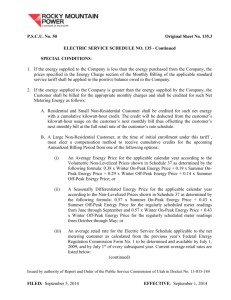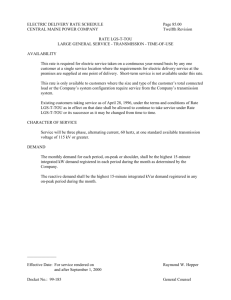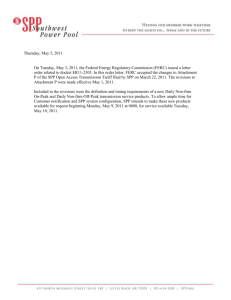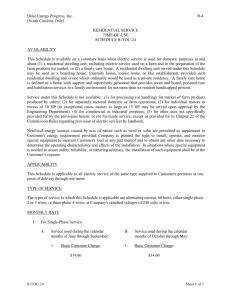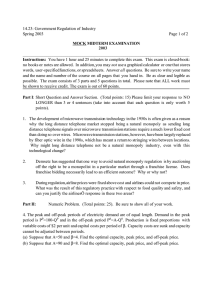Understanding Large Commercial Electric Bills
advertisement
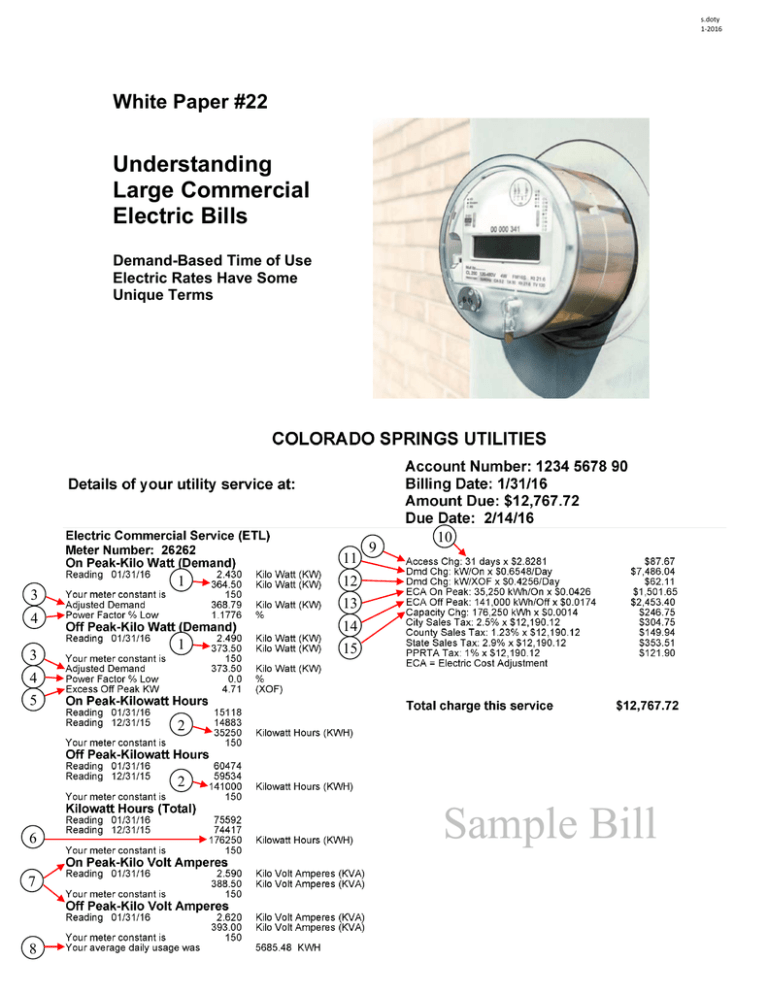
s.doty 1-2016 White Paper #22 Understanding Large Commercial Electric Bills Demand-Based Time of Use Electric Rates Have Some Unique Terms 1 3 4 3 4 5 1 11 12 13 14 15 9 10 2 2 6 7 8 Sample Bill Specific Line Items 1 2 3 4 Line Item How it is Calculated Explanation Demand Measurement Energy Measurement Adjusted Demand Measured separately for OnPeak and Off-Peak periods. Measured separately for OnPeak and Off-Peak periods. Measured demand multiplied by the factor (1 + PF) where PF is the difference between 95% and actual power factor. Power or maximum rate of energy draw from the system during the period. Energy consumed during the period. Power Factor % Low 5 XOF Excess Off Peak 6 Kilowatt-Hours (Total) Kilo Volt-Amperes 7 8 Average Daily Usage Calculated separately for OnPeak and Off-Peak periods. The difference between measured power factor and 95%. Calculated separately for OnPeak and Off-Peak periods. The difference between adjusted Off-Peak and OnPeak demand, in kW. Sum of On-Peak and Off-Peak kWh Product of two measured values. kVA = (volts * amps) /1000. Measured and calculated separately for On-Peak and Off-Peak periods. Total On-Peak and Off-Peak kWh divided by the number of billing days. See also “Power Factor Adjustment”. The measured electrical demand is adjusted (increased) if customer power factor is too low. If a customer power factor is 10% below our threshold of 95% PF, the measured demand is adjusted up by 10% and is the basis for the power factor charge. This is the amount below our threshold of 95%. A value of 5% Low would be a power factor of 90%. It is the amount, in percent, lower than 95%. This forms the billable kW for Off-Peak demand charge, which is billed only on the Off-Peak demand kW that is greater than the On-Peak kW. The subtraction occurs after adjustment for power factor, i.e. with adjusted demand values. The result cannot be less than zero. This is the total electric energy usage for the period. Volts, Amps, Watts, and Power Factor are related. Customers interested in their power factor can calculate it from their bill, from PF = kW/kVA. For the sample bill, the PF is 364.5 kW/388.5 kVA = 93.82%. When this figure is above a threshold, commercial customers with increasing loads will move from a non-demand rate to a time of use rate with separate charges for energy and demand. Customers can also use the figure for general energy management purposes. Line Item How it is Calculated 9 Access Chg. (Access Charge) 10 Bill Days 11 Dmd Chg: kW/On On-Peak Demand Charge 12 (Dmd Chg: kW/Off) Off-Peak Demand Charge Daily fee multiplied by the number of days in the billing period. The number of days since the prior meter reading The highest demand measured during On-Peak hours, in kW, multiplied by the number of days and the charge per-kW On-Peak. The highest demand measured during Off-Peak hours, in kW, multiplied by the number of days and the charge per-kW Off-Peak. However, the only billed kW is the amount of kW that is greater than the On-Peak kW. 13 ECA On Peak: kWh/On On-Peak Energy Charge ECA Off Peak: kWh/Off Off-Peak Energy Charge Capacity Chg. Capacity Charge 14 15 Energy used (kWh) during OnPeak periods multiplied by the rate per-kWh On-Peak. Energy used (kWh) during OffPeak periods multiplied by the rate per-kWh Off-Peak. All energy used (On-Peak kWh + Off-Peak kWh) multiplied by the per-kWh rate. Explanation Unlike On-Peak Charge, the only amount of demand billed for this time period is any amount that is greater than the On-Peak Demand. For example, if the On-Peak demand is 200 kW and the Off-Peak Demand is 150 kW, the Off Peak Demand Charge is zero. If the On-Peak demand is 200 kW and the Off-Peak demand is 250 kW, the Off-Peak demand charge is based on 50kW....just the portion that exceeded the On-Peak kW. For most customers, the majority of demand charges will be for OnPeak. General Concept Descriptions Electric Energy (kWh). Electric energy is measured in kilowatt-hours “kWh”. It’s like the quantity of fuel used by a car in a month’s time. Depending on the time of day, we may run different types of equipment and use different types of fuel. For reasons such as these, the cost of the energy component of the bill varies between On-Peak and Off-Peak times. Electric Demand (kW). Electric demand is measured in kilowatts “kW” which is instantaneous power we provide to the facility. It’s like the horsepower rating of a car engine and is a rating irrespective of time. The demand for power from the facility must be met with installed infrastructure and generation capacity, and helps determine the size of the equipment and wires we install. When the overall demand of all customers combined is too great, we must increase the infrastructure. Time of Use rates charge more for On-Peak use, encouraging customers to use power Off-Peak if possible. OnPeak times – when our system is pushed the hardest - generally coincide with normal daytime business hours; of these times the most intense loads are felt on hot summer afternoons from air conditioning loads. Large customers have special meters that record the demand during our On-Peak and Off-Peak times, for billing purposes; electric cost is different for On-Peak and Off-Peak periods. The recorded value represents the highest fifteen minute average power draw during the period. The fifteen minute averaging window moves ahead each five minutes and is termed a ‘moving window’. Because the maximum demand is averaged over 15 minutes time, momentary events, such as starting of a motor, have only a very small impact on the maximum demand. However, turning on sustained loads (like electric heaters) all at once can ‘set’ the maximum demand for the billing period. Power Factor Adjustment. (See separate White Paper #23: Power Factor Correction). In general, the term “power factor” is the portion of the total volume of volts and amps delivered to a facility that is not recorded on our watt meters. Our energy billing is based on “kilowatt-hours” which is true power. For many electric uses, such as motors, a portion of the “apparent power” (product of volts and amps) is consumed by magnetic energy used to run the motor. This “reactive” power occupies space in our cables and generators but isn’t recorded on the watt meters. For large customers (those with demand meters) we measure power factor and create power factor charges for facilities with low power factors. We allow up to 5% of the total apparent power to be reactive, but if there is more than that we add a “power factor charge” to the bill. The power factor charge is not a separate line item, but it can be identified. Our billing system uses measured demand (‘reading’) and ‘adjusted demand’ or the difference between the two representing the effect of power factor. A power factor of 95%-100% is not charged at all; only power factors lower than 95% are charged. If a facility has an 85% power factor, the power factor is 10% below the 95% free limit – so, for this example, the measured demand is adjusted upwards, making the billing demand higher by 10%. The increase in the demand charge is the value of the power factor charge. For example, if the billing demand is 10% higher than the measured demand, this tells the customer that 10% of the demand charge is from power factor (the embedded power factor charge). How We Recover Electricity Costs Access and Facilities Charges: Access and Facilities charges are designed to recover customer related costs such as metering equipment and customer care expenses. Demand charges: Recovers costs of assets and infrastructure for the electric system; equipment that must be in place to serve the highest load even when not used consistently. Demand charges also recover most maintenance and repair costs; the majority of all non-fuel costs are recovered through demand charges. ECA on peak: Recovers fuel related operational costs including coal, natural gas, and purchased power. ECA off peak: Recovers fuel related operational costs including coal, natural gas, and purchased power. Time of use rates vary between On-Peak and Off-Peak to match the higher market costs of providing energy during periods of peak use. On-Peak / Off-Peak Hours On-peak periods Oct. - March: 4 to 10 p.m. Monday through Friday On-peak periods April - Sept.: 11 a.m. to 6 p.m. Monday through Friday Off-peak periods: all other hours plus legally-observed holidays Capacity charge: Recovers cost of fixed capacity payments, which Utilities makes to the Western Area Power Administration (WAPA) for assured delivery of purchased power to Utilities system. Other Recovered Costs in Access and Demand Charges • Costs for Surplus Fund (like a franchise fee) paid to the municipal government. • Costs for DSM (Demand Side Management) rebate programs. • Costs for communications. • Costs for other community programs such as low income assistance and support for local organizations. Taxes: Springs Utilities collects taxes on utility services and disburses them to the appropriate entity.
